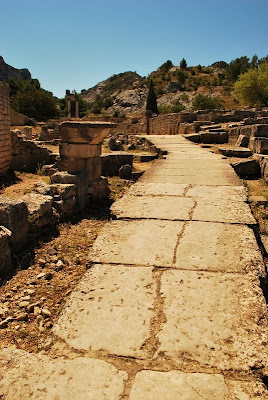If you crossed the olive grove from the asylum of Saint Paul-de-Mausole (as Van Gogh may have done while he lived there) past the scene painted in Olive Trees with the Alpilles in The Background, you might be startled by this sight.
And this.
For two millenia, these were the only visible remnants of an ancient Roman city that was still buried in Van Gogh's time, and so escaped the wild representation of his brush. But, had he known what lay underneath, The Starry Night would have looked very different.
 |
| The Mausoleum of the Julii (40 BC) and the Victory Arch (10-20 AD) |
The Mausoleum of the Julii (the best preserved mausoleum of the ancient world) and the Victory Arch hinted at the existence of a lost city. In 1921, two men fancied a dig and unearthed an insightful look at the life and times of the ancient city of Glanum.
 |
| All roads lead to Rome. The main throughfare in Glanum was linked to Via Domitia and Via Augusta, connecting Spain and France to Italy. |
I underestimated the size of the city. It stretched so far that the end was hardly visible from the entrance, and yet the excavation is still ongoing. I don't think we have really seen all there is to see.
But from what we know, the path we took is also a trip back in time. From the road that you can see on the left, the Roman city began with a few houses,
a forum for noblemen,
a bath house with cold, lukewarm and hot water,
 |
| The remaining roof tiles of the baths (75 BC. Rebuilt in marble in 161 AD.) |
 |
| The mask that spits water into the pool. Classy. |
a marketplace,
some temples and chapels,
 |
| A temple to Hercules, with podiums for offerings. |
 |
| The Corinthian Temple |
mansions,
 |
| H spots a doorway and goes straight to work. Old habits. |
a public hall for conducting business,
| Karate Kid business. |
an underground water source,
and most importantly - a sacred well dedicated to the god Glanis or Glan. It was the reason why Glanum was erected in the first place.
 |
| H stares down into the sacred pool. I saw something stirring within. |
And past certain points, the architecture changes. The layers get older as you go higher and further into the city.
 |
| The Temple of Valetudo, a Greek shrine (39 BC) |
The buildings change from Roman to Hellenistic, with an area that overlaps the Gallo-Roman and the Gallo-Greek; after which there appears a gateway, a definite attempt to divide the Romanesque from an older Greek section of Glanum. And then, there is another division - an older section further up which turned out to be the most ancient part of the city.
 |
| The end of the road. This is the Gaulish part of Glanum and the tour ends here. Ironically, it used to be the entrance to the city, and fortifications were built here to protect from invasion. |
 |
| The Roman walls were bult over Greek walls which were in turn built over Gaulish walls. |
After the defeat of the Roman Empire, the city fell on hard times. The residents were sacked by German tribes, so they moved to what is now Saint-Rémy-de-Provence. Abandoned, the remains of the formerly well-to-do city was ransacked for stones to build the foundations of the new settlement in 260 AD.
But as I stared at the chalky rocks that loomed over the oldest part of Glanum, I wondered whether the city was much older than 150 BC. It is nestled under a cliff spotted with half-concealed caves that may have been the homes of earlier settlers, who later learned to build much more comfortable dwelling places, who learned to worship and build temples, and learned that certain things - like faith and sacred wells and elixirs of life - could forestall death. And so, they stayed.
There was recent article on National Geographic that puts forward the theory that religion (not agriculture) gave birth to civilization. It was the urge to worship that made man abandon his nomadic ways, and not the discovery that he can cultivate his own food.
But these are just conjectures, so don't take me seriously. One day, the people of Glanum decided the sacred well was hardly worth the effort anymore. And so the city passed on to myth, and then lost.
 |
| Plane trees along the "romantic" road to Les Baux (le baw). |
Time seemed to stand still while we were there. There were no clouds, the wind did not blow, the sun didn't seem to move. We only realized we stayed for about two hours in the site when we came out, thirsty and weakened by the relentless heat. It was way past noon when we reached another ancient settlement between Saint-Rémy and Arles, this one considerably younger compared to Glanum.
Up Next: The Great Les Baux-sky
Related Posts:
A Year in France Celebration (The Aftermath)
Sizzling Beach 1, Sizzling Beach 2, Sizzling Beach 3
Bella Italia 1, Bella Italia 2, Bella Italia 3, Bella Italia 4, Bella Italia 5
Provencal Lass 1




















No comments:
Post a Comment